Note: I am giving an online presentation tonight on “Economic Liberty and the Constitution.” My talk is part of the Constitution Day Celebration sponsored by the Freedom Library in Yuma, a libertarian organization in Yuma that has long been educating people on the Constitution and economics. Anyone can tune in to my talk online. Admission is free. The Zoom link is here. My talk will begin at 8 p.m EASTERN time.
******
I just returned from a long road trip to Texas, where I visited family members. I had an interesting experience that I would like to share with you all, one involving a bit of family history.
I was returning from San Antonio to Dallas, but instead of taking IH35, I decided to do a tour of the Texas hill country, which is situated north of San Antonio and east of Austin.
My father’s family, which was German in ancestry, owned a tract of land in the hill country in a small town called Leon Springs, which is near the town of Boerne. When I was young, we spent summer vacations at our place there at Leon Springs and went to church in Boerne.
I hadn’t visited Boerne since I was a kid and so I figured that this was a nice opportunity to do so. As I traveled through the town, it was not difficult to see why it has become one of the most popular retirement places in Texas. It is a beautiful, quaint, little town with a really nice downtown area.
Like other towns in the hill country, there is still a strong German culture in the area, That’s because the Texas hill country was where thousands of German immigrants settled in the 1800s.
The town of Fredericksburg is also really nice. It’s larger than Boerne. Its main street and downtown area has plenty of German pubs and German restaurants.
Where I had my interesting experience was in Comfort, a very small town in between Boerne and Fredericksburg.
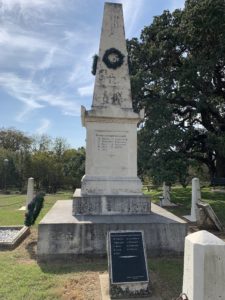 My brother told me that there was a Civil War monument in Comfort that might interest me. When I got to Comfort, I couldn’t find it in the downtown area. I asked a guy at a service station if he was familiar with a Civil War monument in town. He told me that it was outside the downtown area and gave me directions.
My brother told me that there was a Civil War monument in Comfort that might interest me. When I got to Comfort, I couldn’t find it in the downtown area. I asked a guy at a service station if he was familiar with a Civil War monument in town. He told me that it was outside the downtown area and gave me directions.
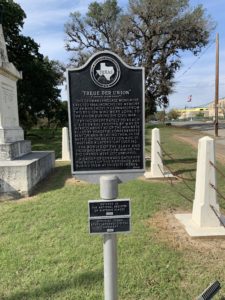 When I got there, I got out of my car to read the plaques around the monument and take some pictures.
When I got there, I got out of my car to read the plaques around the monument and take some pictures.
The monument was built in 1865, just after the Civil War had ended. There are around 30 German-American men buried under the monument.
Many of the German settlers were opposed to slavery, conscription, and secession. They had no interest in fighting on behalf of the Confederacy. After the Civil War began, however, the Texas legislature declared martial law and required everyone to take loyalty oaths to the Confederacy.
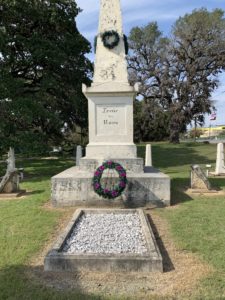 Around 100 German-Americans decided to go south, toward Mexico. A Confederate force intercepted them at the Nueces River and the Rio Grande. In the ensuing battles, all 100 men were killed, including those who had been wounded in battle. They were all considered traitors.
Around 100 German-Americans decided to go south, toward Mexico. A Confederate force intercepted them at the Nueces River and the Rio Grande. In the ensuing battles, all 100 men were killed, including those who had been wounded in battle. They were all considered traitors.
I took pictures of the monument and the old plaques surrounding it. There was also an American flag flying at half-mast. I later learned that it was one of the few places in the United States where it is permitted to fly a flag at half-mast on a perpetual basis.
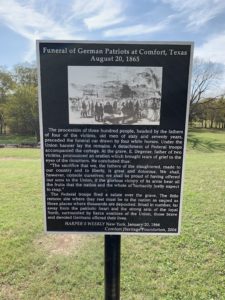 Then I noticed a newer plaque. I approached to read it and was stunned. The plaque stated that in 1865 three men had paid $20 to purchase the plot of land on which the monument was built. Among the three was William Heuermann, who was my great-great grandfather, for whom my brother William Heuermann Hornberger is named.
Then I noticed a newer plaque. I approached to read it and was stunned. The plaque stated that in 1865 three men had paid $20 to purchase the plot of land on which the monument was built. Among the three was William Heuermann, who was my great-great grandfather, for whom my brother William Heuermann Hornberger is named.
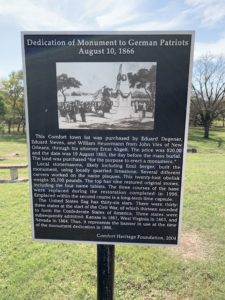 Obviously, buying that plot of land and building a monument to men who had been considered traitors was a rather courageous thing to do, given that the Confederacy had just lost the war.
Obviously, buying that plot of land and building a monument to men who had been considered traitors was a rather courageous thing to do, given that the Confederacy had just lost the war.
As an aside, here in Virginia, a Civil War hero named John Mosby, a lawyer from Leesburg, had decided to support Ulysses Grant in his post-Civil War presidential bid. That was because Grant had granted Mosby’s wife’s appeal to release him from custody at the end of the war rather than try him as a war criminal. Mosby paid a big price for supporting Grant. Although he was one of the Confederacy’s greatest military heroes, his fellow Virginians ostracized him for decades.
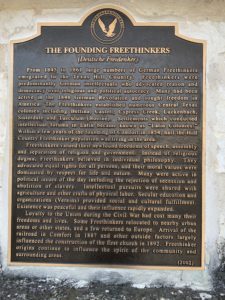 Obviously, my great-great grandfather didn’t care about what people said about him. He built that monument because he obviously believed it was the right thing to do and because the men who had been killed had been friends of his or children of friends of his.
Obviously, my great-great grandfather didn’t care about what people said about him. He built that monument because he obviously believed it was the right thing to do and because the men who had been killed had been friends of his or children of friends of his.
When I went into the downtown area of Comfort, I notice a big plaque that described the “Freethinkers” movement in Texas, which I had never heard of.
In the German revolution of 1848, there were Germans who were opposing the monarchy and fighting in favor of constitutional government. When King Frederick William IV defeated them, many of them decided to move to America. They settled in the Texas hill country. My great-great grandfather, who came here in 1847, was clearly one of them.
Unlike the waves of penniless immigrants who were flooding into America, these German immigrants were educated and well-to-do, consisting of doctors, engineers, and the like. After settling in the hill country, one of their favorite activities was to engage in discussions about politics and economics.
While I’m sure that the Freethinkers didn’t agree on every issue, it seems that they were largely committed to such principles as freedom of speech, separation of powers, constitutionally limited government, separation of church and state, opposition to conscription, and opposition to slavery.
From what I can tell though, it wasn’t entirely positive. Some of them favored a progressive income tax and others leaned toward Marxism.
But I have no doubts that the tendency toward independent “freethinking” that characterized by great-great grandfather is part of my libertarian DNA! I guess you can see why that little trip to the Texas hill country was so interesting and meaningful to me.
My great-great grandfather later moved to San Antonio and became a partner in the firm of Hugo, Schmeltzer, and Heuermann, a general store.
Finally, you might be interested in this tidbit. The Alamo consisted of a church and a convent. Hugo, Schmeltzer, and Heuermann purchased the Alamo’s convent in 1848 and used it in their business. After the Texas legislature appropriated $65,000 for the purchase, the property was conveyed to the Daughters of the Republic of Texas in 1905.
Just in case some of you might be saying to yourselves, “Yeah, sure, Hornberger, now you’re telling us that your ancestor once owned the Alamo,” please check out these websites:
https://www.thealamo.org/remember/commerce-and-preservation
https://www.drtinfo.org/drt-library/research/alamo-history-chronology-2 (Scroll down to 1886)
For a more detailed article on on the Texas Freethinkers, see “Freethinkers of the Early Texas Hill Country” by Edwin E. Scharf.
The post Freethinkers in Texas appeared first on The Future of Freedom Foundation.
* This article was originally published here
HELP STOP THE SPREAD OF FAKE NEWS!
SHARE our articles and like our Facebook page and follow us on Twitter!





0 Comments